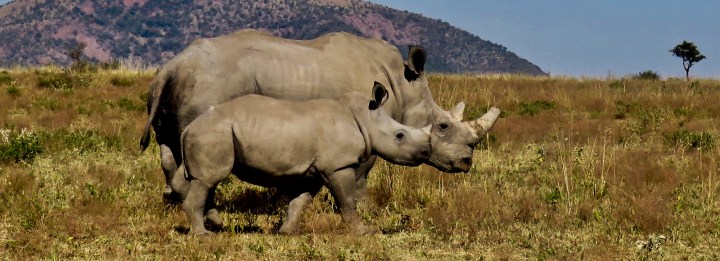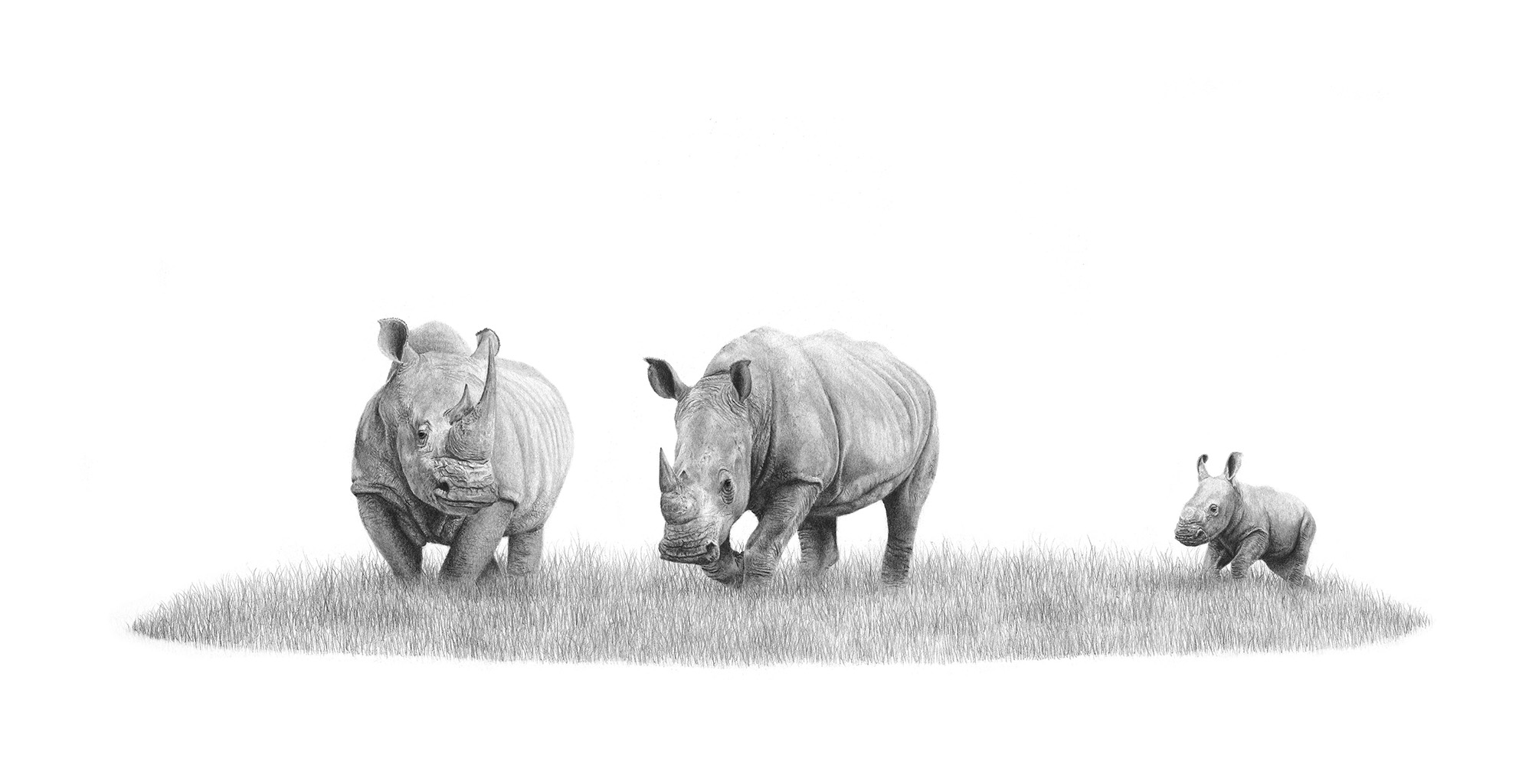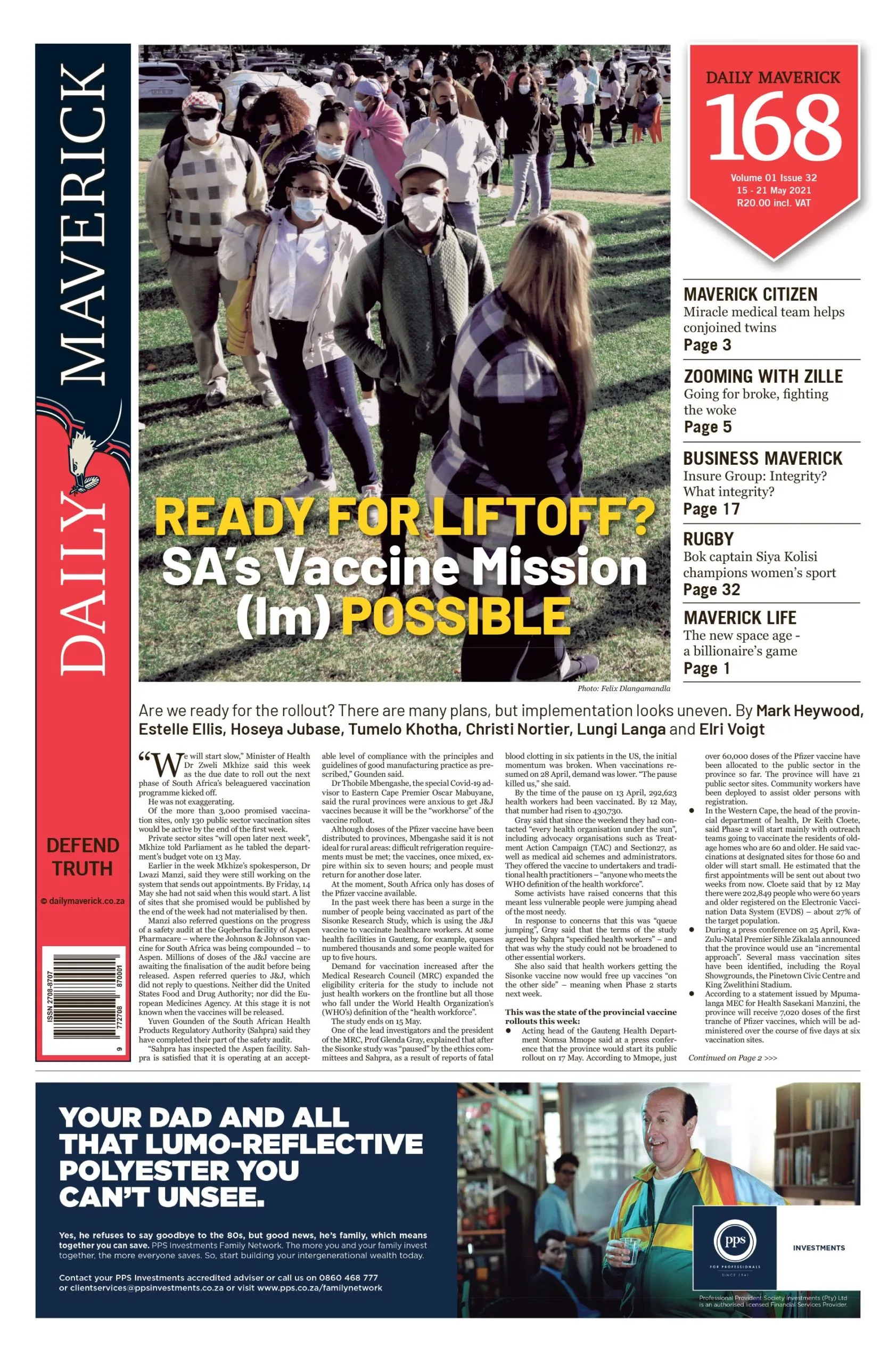OUR BURNING PLANET 168
The future of rhinos: What it will take to save an endangered ancient species

Daily Maverick 168 organised a discussion with stakeholders about the future of rhinos. Taking the debate about legal sales of rhino horn off the table helped to bring different viewpoints together.
First published in the Daily Maverick 168 weekly newspaper.
In a meeting of rhino owners, wildlife vets, conservation NGOs, eco-economists, security experts and SANParks organised by Daily Maverick 168, the outline of a conservation framework began to emerge to offset the alarming decline in the number of wild rhinos in South Africa, where most live.
Key to this would be patrolled strongholds within and outside national parks until poaching can be brought under control. We also need a new global narrative that sees all rhinos as an international herd and a biodiversity treasure. And every rhino keeper, state or private, should be regarded as their custodians.
In a previous article we outlined the problems and bitter polarities in the rhino debate. Asking for a relaxation of entrenched positions with a view to solutions, we called together a wide range of people with specialist knowledge.
Everyone who participated in the crisis Zoom meeting, facilitated by the Wilderness Foundation Africa, was keenly aware that the hands of the rhino clock are perilously close to midnight. When we took trade in rhino horn off the table, they found surprising common ground in their concerns and a need for collaboration.
Participants underlined the importance of acknowledging that there are many types of custodianship: state/public, private conservation and commercially farmed. There are also foreign owners and mines with rhinos on their land. All of these need to work together to conserve rhinos. This should also be the mandate of rhino conservation NGOs.
“There’s a problem of saying government has custodianship of rhinos and private owners have ownership,” said Peter Straughan, who manages an eco-lodge and a small crash of rhinos. “It causes real problems in public perception. We need to change the narrative. We’re all custodians. If we look at it this way, it could start to break down present polarities.”
Private rhino ownership began as a way to expand the protected area base for conservation. In the 1950s there were fewer than 500 white rhinos in South Africa. Most were placed in Kruger Park because it had the habitat and range. Then poaching ratcheted up, causing the decimation of rhinos in the park.
Thanks to the visionary work of Dr Ian Player, the population grew to tens of thousands. Then, in 2007, industrial-scale rhino poaching took off.
At that time, South Africans came together passionately to combat the growing scourge. With NGOs dedicated to ending the crisis, donations poured in. People had plastic rhino horns attached to the grills of their cars. They wore beaded rhino bracelets and sported Save the Rhino car stickers. There was a feeling that we would prevail.
Today, however, compassion fatigue has set in. This has been compounded by the impact of Covid-19 on lost livelihoods and uncertainty about the future. With serious poverty and suffering, how does one add rhinos to the equation?
We now have a situation where most of the country’s – and therefore the world’s – rhinos are in private hands. But as poaching on state lands sees rhino numbers plummeting, private owners facing a poaching onslaught can no longer afford to protect them and many are looking to disinvest in rhinos.
The meeting was to see if there was a way forward, and the consensus was that there is a way if we have the commitment. Here’s a possible scenario stitched together from the ideas put forward by the participants.
Jump forward in time to 2035. South Africa basks in global acclaim for successfully implementing a strategy that yet again pulled the rhino from the brink of extinction. Rhinos are regarded as essential eco-warriors, highly prized powerhouses that manage grasslands, prevent fires by close cropping (they create “grazing lawns”) and cultivate carbon sinks, helping to reduce carbon emissions in a world fighting climate change.
In a scenario we can envisage, global financial agencies issue bonds that protect all rhinos. International corporations pay fees for carbon credits for every adult rhino as a carbon-sequestering, keystone species.
Merchants in the legal international exotic animal trade agree to pay a tax that offsets the high cost of security for South Africa’s rhinos, while also funding highly targeted, global anti-poaching and demand-reduction marketing campaigns.
But back to the present: how do we get from here to there?
To enable open discussion, the contentious debate surrounding the sale of rhino horn had to be held in abeyance. For the purposes of the group’s discussion and this article, it was agreed that it be taken off the table. Here’s why.
Many conservation NGOs are anti-trade, convinced that legalised horn sale would fuel increased demand and doom the remaining rhinos. But private and public rhino custodians hold stockpiles of horn cut over the years to deter poaching – a veritable goldmine that private rhino owners hope could defray monumental security costs. Between these two poles is a clash of paradigms.
The sale of rhino horn was banned on the international market in 1977 by the Convention on International Trade in Endangered Species (Cites) and that’s not likely to change any time soon. But constant lobbying by commercial rhino operations has been a stumbling block in meaningful action to save the species.
Participants in the discussion held unshakable views regarding horn sale. To agree to silence that debate was a major concession on their part. On a range of other topics there was remarkable and – for many participants – surprising accord. These are some of the conclusions.
The status quo spells doom for rhinos. Kruger alone allocates R200-million a year to its anti-poaching budget, yet currently loses 200 rhinos a year. This means each animal is a million rand lost.
This is unsustainable.
All rhino species must be regarded as an international herd that needs protection for the Earth’s biodiversity and not merely as state or private animals.
The language of the debate must change from antagonism to collaboration. There was agreement that the immediate future of rhinos hinges on public and private custodians, NGOs, scientists and environmentalists working together.
Poaching is at critical levels and the acting CEO of SANParks, Dr Luthando Dziba, acknowledged that Kruger Park needed help to deal with it.
“Our Rhino numbers have been in decline and that trend continues unabated,” he said. “We have relentless poaching despite all of the financial resources we’re putting into it. A problem is that we’re losing rhino cows to poaching, which has an impact on future generations.
“We usually lose the young calf with the cow and possibly an unborn calf if the cow’s pregnant. It’s eating into the total rhino population.
“Our investments are not returning the kind of reduction in poaching that we’d like. We’re reaching levels where we need to find alternatives that are safe but viable in terms of the size of land for growing a healthy population outside Kruger.
“We’re very open to open discussions on drastic interventions that could help us to ensure a protected population both within and outside our parks.”
In the protection of wildlife, local communities are key stakeholders. “We’re looking how to integrate local communities into rhino conservation so they have a stake in a living rhino rather than a poached one,” said Dziba. “We need to arrive at a position where if a person touches a rhino it becomes a community matter. Innocent people in communities are being corrupted by organised criminals. We have to break that link.”
Gabriel Fava of Born Free noted that mobilising the resources needed to protect and conserve rhinos will come down to recognising the true value they make to the ecosystems on which we all ultimately rely. “Any benefits arising from that recognition must be equitably shared with local communities if we are to disincentivise poaching and promote wildlife guardianship by those living closest to rhino populations.”
Strongholds were a central theme of the discussion. Until poaching can be brought under control, all rhinos need to be gathered within well-protected areas on state and private land. This will require state, bequest, private, international conservation tax and international donor funds. Private custodians who keep rhinos for conservation need support and tax relief.
“It’s time for the private guys to stand together with the government and say we need to do something, set some rules and try and prevent poaching,” said Marius Kotze who owns a private game reserve with rhinos. “Guys are just leaving their rhinos unprotected now.”
Bruce “Doc” Watson, co-founder of Dimension Data and Connected Conservation, agreed: “Government or the state has to work together with the private landowners. And without their support there, we’re not going to succeed in saving rhinos.”
Until the present poaching tsunami abates, all strongholds need to be fortified by fences, high-tech security, motion sensors, drones, gunshot detectors, dogs, guards on horseback and armed foot soldiers.
“We need to make safe havens a priority,” said Andrew Muir of the Wilderness Foundation Africa. Johan Marais of Saving the Survivors agreed: “Growing numbers of secret strongholds are popping up throughout South Africa and protected areas in East Africa, including Kenya and Tanzania,” he said. “They show remarkable success in protecting their rhino. You have a smaller area with a higher number of animals that can be better protected, whether within a national park or outside it.”
Dziba said it would be easy to set aside 10,000 to 15,000 hectares within the Kruger National Park that could be intensely protected.
“If we establish a stronghold within Kruger,” he said, “we’re going to need resources and collaboration from private sector partners to ensure that we have zero poaching within that area.”
Ethno-biologist Helen Lunn cautioned, however, that “we need to acknowledge that strongholds are a language of retreat. They’re a reaction to the poachers, not an answer for rhinos.” But in the midst of a crisis they’re an essential stopgap.
A Kruger stronghold would not be without its problems as a safe haven for rhinos, Dziba noted, and acknowledged that there are “internally compromised staff who have been corrupted by organised crime syndicates.”
But what incentive would private owners have, to hand over rhinos to a stronghold in Kruger? According to Dziba, it’s a numbers game – you can only keep a limited number of rhinos per hectare, so housing privately owned rhinos is not a sustainable solution.
“There has to be some guarantee that they’re going to be preserved,” said Kathryn Straughan, who owns a small rhino crash with her husband Peter. “We don’t want them to die. It’s personal to us!”
Rian Labuschagne, who with his wife Lorna ran Zakouma National Park in Chad for African Parks and stopped elephant poaching in its tracks, said an open ecosystem like Serengeti-Mara-Ngorongoro was best, “but if all other measures are failing, then strongholds are imperative”.
Private custodians have a better anti-poaching record than the Kruger National Park. Whereas public entities are struggling to reverse the collapse in numbers, many private farms have managed to keep their rhinos safe in the smaller properties, comparable to small national parks. In some areas where poachers did hit private farms, owners banded together to supply collective security, reducing poaching to zero.
“One thing I had to learn very quickly was that every private rhino owner is a conservationist,” said Tersia Jooste of Rhino Connect, an organisation that represents 40 private rhino owners. “But these conservationists had to turn into soldiers, because they’re part of a war. They had to change the whole mindset.”
A private/government fund is needed to underwrite the cost of security held by private rhino owners who, while protecting the national herd, are incurring massive bills for ongoing security. Some have been forced to get rid of their animals.
There are problems with a declining gene pool. “The reason for us wanting to sell rhino,” said Straughan, “is we can’t have interbreeding here. We’ve only got a small herd and the two young males need to be moved on so they don’t breed with their own mothers and sisters. We’re trapped in a situation where there’s no value.”
Situations like this could threaten the long-term viability of the herds, endangering the rhino in yet another way. Some participants advocated creation of a system where bulls could be shared, perhaps including males from Kruger Park.
Bovine tuberculosis within the Kruger’s rhino population is a problem.
“We were selling rhinos to private owners with rhino strongholds in areas that were safer,” Dziba said. “Then we were hit by the discovery of TB in rhinos and the Department of Agriculture imposed a quarantine on Kruger. We’re not able to sell animals or move them out without a test to certify them being TB-free and that’s very expensive to administer.
“This has been a major setback for conservation, because we thought we’d be able to remove a significant number from harm’s way and contribute to growing rhino numbers.”
“TB is a very difficult disease,” wildlife veterinarian and founder of The Rhino Pride Foundation Dr Jana Pretorius agreed. “And today, it’s pretty much throughout Kruger.”
TB in rhinos can be managed, however, because its consequences are not as severe as they are for Cape Buffalo, for example. If the Kruger rhinos can be kept safe in a stronghold, they can breed and the numbers will increase, despite the reality of a TB-compromised crash.
We decided to look into sustainable use and found there was no supply-chain transparency in the wildlife trade. I would prefer a conservation model, but if we’re going to have a trade model, without transparency there’s no proof of sustainability. Sustainable use is an ideology and not a strategy.
Perceptions are key, said Lynn Johnson of Nature Needs More in Australia. “We were researching demand reduction campaigns but we stepped out because the trade debate was going on so long and pushing that line is incompatible with demand reduction.
“We decided to look into sustainable use and found there was no supply-chain transparency in the wildlife trade. I would prefer a conservation model, but if we’re going to have a trade model, without transparency there’s no proof of sustainability. Sustainable use is an ideology and not a strategy.
“I agree with Lynn,” said eco-economist Ross Harvey. “Demand will never be completely eradicated. But it does have to be radically reduced. And in order to do that, you need demand reduction campaigns, not information or awareness raising campaigns.”
The commodification of rhinos and horn is a major issue, noted Smaragda Louw of Ban Animal Trading. “The problem is if we give rhinos worth. Once they become private property, it becomes very difficult for NGOs – which are there to hold government accountable – to see where these animals are going. Giving animal and horn value is not a way to protect rhinos. This has huge implications for investment in the country.”
It’s time the international community stepped up to help to save rhinos. “One of the things we’ve been pushing is for the legal trade in endangered species to pay a levy,” said Johnson. “The value of the legal trade in endangered species is probably over US$500 billion today.
Some of the biggest companies in the world benefit from legal trade, be they luxury brands or architects or property developers. If they were paying 1% to 2% of the value of the legal trade into a central pot for conservation, you’d have a large fund for wildlife protection. Other industries pay a levy, so there’s no reason why companies profiting from the trade in endangered and exotic species should be exempt.”
We need to rethink stewardship – that was the view of Andrew Muir. “Stewardship is among the most powerful environmental legislation in our country and I don’t believe it’s been used adequately. It’s presently only about land. I think we need to lobby as a collective to add rhino and other important species to stewardship legislation so there’s a tax incentive. Not only to protect land for conservation but protect rhinos for conservation.”
Rhinos are climate warriors. “Talk of saving the rhino typically centres on preserving an ancient resource for posterity, said Lunn. “But focusing on the rhino’s income potential from tourism and the benefits that can flow to surrounding communities fell short of the rhino’s true importance.
“The rhino’s doing an unbelievable job in maintaining our climate and it does so disproportionately to other species. Rhinos are massive proliferators of seeds of grasslands through its dissemination of seeds.”
A University of California study found that grasslands are more resilient carbon sinks than forests in this unstable climate. “That should be part of the basis of our appeal to the world to support rhinos as creators of carbon sinks. This could be offset against carbon credits bringing much needed support to those taking care of rhinos.”
In conclusion to the debate, Muir said the key was to have rhinos protected for conservation with a management plan that protects them for the public good and the good of the planet.
“Then we could lobby for funds, both locally and internationally. But to engage locally and internationally you have to get trade in horn off the table.” The success of the debate underlined that conclusion.
We owe it to rhinos to let them live without persecution. Our lives are richer when we stop to marvel and reflect on what the wild creatures that share this planet have to teach us.
And a final note from a rhino. While we brainstormed her future, a 40-year-old rhino named Delilah (below) was quietly going about her morning in a remote location atop a mountain. Sitting quietly at the edge of a pan with two younger bulls by her side, her head, with its graceful, arching horn, rested amid a cluster of yellow flowers.
Beautiful and benign, her gaze seemed thoughtful. Did she understand the difficulty facing her ancient species? She’s an old rhino, a true elder. She’s witnessed poaching, heard the crack of gunshots and panicked humans shouting. But that morning everything was quiet. The pan reflected the surrounding grasses and trees and the three rhinos on its banks. Delilah contemplated the warm day, safe in her remote sanctuary, as we crouched behind cold computers, debating the future of her species. DM168
This story first appeared in our weekly Daily Maverick 168 newspaper which is available for free to Pick n Pay Smart Shoppers at these Pick n Pay stores.
























 Become an Insider
Become an Insider
Thank you for a great article.
Ian, on what basis do you know that local farmers can supply a market which consists of over a billion Chinese and millions of Vietnamese? It has been estimated that SA can supply 5 tonnes of horn a year. At the height of the poaching it’s estimated that over 70 tonnes a year was entering Asia.
For many years good people have been trying to reduce demand, with no success. Why is reduced demand still offered as a solution? Much rather increase supply through private ownership. Farmers will be able to meet demand no matter how big it gets. With a legal supply of horns, poaching will reduce.
Who estimated the 5 tons? An anti-horn-marketeer? South Africa has by far the most rhinos, so most of the 70 tons must have come from us. If there is a demand, farmers will meet it, admittedly over time, but existing stocks will help. Every person in China wants horn? Use believable figures please.
Could you please point to the study that shows how farmers could scale up to 70 tonnes of horn a year? Or is it just hearsay?
Answer my question. Is it 5 tons or most of 70 tons?
To answer yours: No study, just a belief that given demand at a certain level, farmers would be able to meet it, as they do with the demand for other agricultural products.
“Then we could lobby for funds, both locally and internationally. But to engage locally and internationally you have to get trade in horn off the table.”
Unfortunately some of the most traded animals on the planet are also the least endangered. (chickens, goats, sheep, cattle). I’m not sure it is possible to debate rhino conservation by excluding a discussion on trade. Regrettably the status quo does not seem to be working.